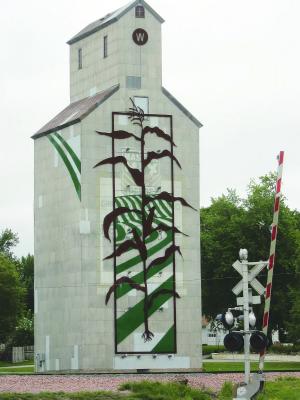Grain Elevator Converted To Eye-Catching Public Art
 ✖  |
A few years ago the folks in Woodbine, Iowa (population 1,459) converted a huge, abandoned grain elevator into a beautiful work of public art that welcomes visitors to the town. The 20 by 20 by 65-ft. tall grain elevator is adorned with a 45-ft. high rust-colored metal corn stalk, set inside a rectangular metal frame that has a colorful green and white-striped field in the background. Wildflowers grace the foreground, and LED floodlights light up the scene at night.
“The town pulled together to save the elevator. The artwork has made it a real point of pride for the community,” says Deb Sprecker, executive director of Main Street, a historic preservation group that spearheaded the project. “The elevator was built in the 1940’s and originally had a feed mill attached to it. About 25 years ago a local co-op stopped using the buildings, and they sat abandoned for 20 years and slowly deteriorated.”
There was a movement to have the elevator razed, says Sprecker. “But taking it off the horizon was going to alter Woodbine’s skyscape, and the old ‘milk carton-shaped’ elevator, perched at the junction of Hwy. 30 and the historic, brick-paved transcontinental Lincoln Highway, had been a prominent Woodbine sentinel for several generations.
The project, fueled by a funding partnership between the city, a local farm cooperative, and Main Street, became a reality after securing grants to assist with tearing down some non-contributing structures, rehabbing the elevator façade, and then working through a community design process to determine what would appear as art on the building.
“The community wanted to save the elevator because so many other wooden elevators in the Midwest have been torn down and lost forever. They really rallied around the project,” says Sprecker.
The field background, which shows contour farming strips, symbolizes a unique formation of wind-deposited soil called the Loess Hills, located in the western part of Iowa along the Missouri River.
Main Street received some grant funding and contracted with TMCO, a Lincoln, Nebraska company, to do the metal work. Emily Broderson designed the artwork.
“We wanted the artwork to be as sustainable as possible so we designed it to last at least 20 years without requiring any maintenance,” says Sprecker. “It’s made with high quality paint, and with LED lights we won’t have to change the light bulbs for a long time.”
Contact: FARM SHOW Followup, Deb Sprecker, Woodbine Main Street, 313 Walker St., Woodbine, Iowa 51579 (ph 712 647-3434; woodbinemainstreet@windstream.net; www.woodbineia.com).

Click here to download page story appeared in.
Click here to read entire issue
Grain Elevator Converted To Eye-Catching Public Art BUILDINGS Miscellaneous A few years ago the folks in Woodbine Iowa population 1 459 converted a huge abandoned grain elevator into a beautiful work of public art that welcomes visitors to the town The 20 by 20 by 65-ft tall grain elevator is adorned with a 45-ft high rust-colored metal corn stalk set inside a rectangular metal frame that has a colorful green and white-striped field in the background Wildflowers grace the foreground and LED floodlights light up the scene at night “The town pulled together to save the elevator The artwork has made it a real point of pride for the community ” says Deb Sprecker executive director of Main Street a historic preservation group that spearheaded the project “The elevator was built in the 1940’s and originally had a feed mill attached to it About 25 years ago a local co-op stopped using the buildings and they sat abandoned for 20 years and slowly deteriorated ” There was a movement to have the elevator razed says Sprecker “But taking it off the horizon was going to alter Woodbine’s skyscape and the old ‘milk carton-shaped’ elevator perched at the junction of Hwy 30 and the historic brick-paved transcontinental Lincoln Highway had been a prominent Woodbine sentinel for several generations The project fueled by a funding partnership between the city a local farm cooperative and Main Street became a reality after securing grants to assist with tearing down some non-contributing structures rehabbing the elevator façade and then working through a community design process to determine what would appear as art on the building “The community wanted to save the elevator because so many other wooden elevators in the Midwest have been torn down and lost forever They really rallied around the project ” says Sprecker The field background which shows contour farming strips symbolizes a unique formation of wind-deposited soil called the Loess Hills located in the western part of Iowa along the Missouri River Main Street received some grant funding and contracted with TMCO a Lincoln Nebraska company to do the metal work Emily Broderson designed the artwork “We wanted the artwork to be as sustainable as possible so we designed it to last at least 20 years without requiring any maintenance ” says Sprecker “It’s made with high quality paint and with LED lights we won’t have to change the light bulbs for a long time ” Contact: FARM SHOW Followup Deb Sprecker Woodbine Main Street 313 Walker St Woodbine Iowa 51579 ph 712 647-3434; woodbinemainstreet@windstream net; www woodbineia com
To read the rest of this story, download this issue below or click
here to register with your account number.







